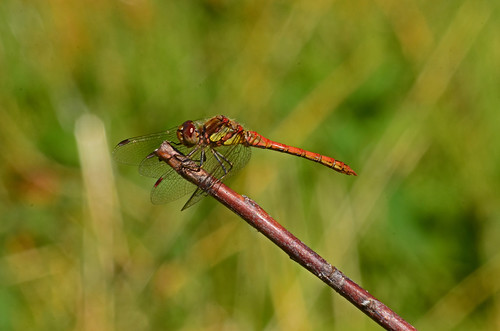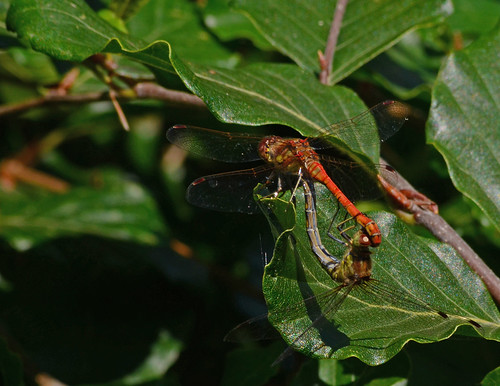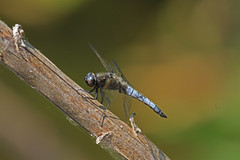One end of my front garden is curved and tapers to a point and was pretty much dead space, so last year I decided that I’d turn it into my own tiny nature reserve and make a pond. The street side of the garden is lined with beech hedge and the open end is bound by a hazel tree which I planted there 5 or 6 years ago, so it is an enclosed space which I hope will remain fairly undisturbed, apart from my forays to photograph the wildlife that takes up residence.
In order to try to maximise the wildlife potential I followed all the instructions on how to create a wildlife pond, so it’s around 30cm deep (which is enough to prevent the bottom from freezing even during the coldest UK winter) and was seeded with plant life and minibeasts from my friends pond, and there are no non-native species and no fish. The water went into it in February this year from my water butt (tap water contains chemicals which are not good for a balanced wildlife pond) and it’s remarkable how rapidly nature has taken hold. As well as all the beasts added by me which seeming to be flourishing, it has been discovered by various species of dragonfly, butterfly and hoverfly, and I put twenty common frog tadpoles in from another friend’s pond, of which at least one reached adulthood.
 Common darter female (Sympetrum striolatum) perched on an iris leaf
Common darter female (Sympetrum striolatum) perched on an iris leaf
In the corner of the garden where the pond is I’ve let the grass and wild flowers grow and I mow a path all the way round, so I can view it from all angles, and in one corner a small patch of stinging nettles is allowed to grow unhindered. In this way I’m hoping that eventually the grassy area will reach a balance with local wild flowers and provide a suitable habitat for a few more insect species. As well as the ubiquitous white butterflies, peacocks, and other regular garden butterflies visiting the garden, since the completion of the pond I’ve also added gatekeeper and speckled wood to my garden species list.
 Common darter male drawing breath after a hard days mating
Common darter male drawing breath after a hard days mating
Apart from the introduced tadpoles, the most interesting visitors to my little zoo have been the dragons, of which I’ve seen at least 3 species of damsel, one darter and one hawker species, all either settled around the pond or hunting over it. Of these, the most notable have been the common darter which are very common in my part of the world, and are often very easy to photograph, and consequently the most frequent species shown here in my posts. But I think they’re incredibly photogenic! And this year in the garden I’ve managed to capture several aspects of their reproductive life cycle.
This pair, in the midst of copulation, were being constantly harassed by a lone male which had taken up defensive positions on the pond and was defending it vigorously. But they were not to be deterred and completed copulation and began ovipositing in the pond despite the unwanted attentions of the loner.
The male common darter has primary and secondary genitalia, the primary genitalia, located on the last abdominal segment, produce the sperm which he transfers to the secondary genitalia on abdominal segment 2 (counting along from the thorax), which contains the penis with which he inseminates the female. Transfer of sperm is done prior to clasping a mate with the anal appendages or ‘claspers’ at the ‘pronotum‘ (a plate of the exoskeleton at the back of her head) in the case of damselfies (Zygoptera), or by the head in the case of the Anisopteran dragons. She then attaches her genitalia to the sperm-containing secondary genitalia of the male and fertilisation ensues.
 The tandem pair, now fertilised, looking for places to oviposit
The tandem pair, now fertilised, looking for places to oviposit
Once the female had been fertilised, they flew around the pond and when they had identified a suitable location the female swung her abdomen downwards to eject an egg into the water. Some species of dragonfly search for specific locations underwater, such as the underside of leaves or within the stems of water plants, to lay their eggs, but the common darters were placing them directly into the water. Consequently they darted swiftly to and fro over the pond and the ovipositing movement was extremely rapid, making photographing the event a challenging task, but I managed one half decent shot:
The next chapter in this story will be when the eggs hatch to release the larvae into the pond, which happens 2-5 weeks after laying the eggs. Dragonfly larvae are voracious predators but there should be sufficient other insect life in the pond to keep them sated, and if I can catch one I’ll post the pictures later. And hopefully I can pphotograph one as it emerges from the water and metamorphoses into the adult dragon, which should happen next year if they survive.






I applaud your efforts, Finn. How fantastic to have this little nature reserve in your back yard! Keep us posted on what happens next. 😉
Certainly will Ruth, it’s remarkable how many beasts have taken up residence already!
You’ve obviously put a lot of time, effort, care and thought into your creation and must be thrilled with the results. Lucky wildlife, I’m not surprised they’re fighting over who gets residence!
It was a bit of a back breaker digging it out but I am indeed very pleased with the result, it’s been fascinating just watching what turns up. I hope now that I get to see some dragonfly larvae and emerging adults. If I’m that lucky I’ll be sure snap some shots and post them here.
How lovely that you have had such beautiful and interesting visitors to your new pond! Your photos of the dragonflies are wonderful. I haven’t seen many damsels or dragonflies this year so it’s nice to see good photographic close-ups of them.
Hello Meanderer, I’m very happy with the number of dragons which have appeared. I’m surprised you haven’t seen many though, the weather this year has been good for them and I’ve seen them in fairly good numbers. Still, I’m pleased I’ve been able in some part to fill the gap!
Sounds like you’ve done an excellent job creating the pond and wildlife habitat. Well done!
Your dragonfly images are well focused too. Reminds me how long it is since I’ve captured one in a photo. I’m lucky enough to live near a small lake with excellent habitat in the Botanic Gardens, but it was too hot to go outdoors last February when the dragonflies and damselflies were regular visitors.
Thanks Vicki, it’s good to be able to photograph all the new species so close to home. So far it’s been quite amazing to see how rapidly the wildlife has colonised such a small piece of water.
What an awesome and informative post Finn. I love dragon flies. Our sudden decent into spring sees me contemplating all things warm and dragon flies and “flies” and getting out into the garden again. I was hoping that winter would drag on a bit longer but it looks like spring is well on it’s way with all of the fruit trees breaking out into flower. That means that you are slowly going to head into your winter but first enjoy that lovely autumn and cheers for the lovely dragonflies to colour my early morning Monday 🙂
Hello Fran, it’s still summer here… just, although we’re in the midst of the tail end of a Caribbean hurricane which drifted across the Atlantic so it’s been very windy with some heavy rain in the last couple of days! I normally think of Autumn starting here at the end of September, but maybe that’s just misplaced optimism 🙂
Glad you like the dragonflies. I’m very pleased they considered my little pool suitable for laying their eggs. Result!
Our spring doesn’t usually start till well into October but we are getting full on spring signals now so I guess nature knows what she is doing (fingers crossed!) it does seem very early to me…
That’s an interesting observation. We had a warm winter and everything started very early this year at this end of the globe, and it looks like that may be mirrored in the southern hemisphere. Up here it’s been attributed to abnormal fluctuations in the jetstream.
Down here they call it “Global Warming” 😉
Same here. Is it generally warmer in Tassie? Up here there are wild swings going on from warm to cold to wet to windy to chuffing cold. And all combinations inbetween!
It feels like Antarctica today and I am feeding the fire like crazy, but it is only 4am and it will probably get to about 13C today (a heat wave 😉 ). That isn’t stopping nature calling spring though. I always trust nature when it comes to calling the seasons. If you trust weathermen you get wet! 😉
Congratulations on your total success with your pond, Finn. I’ve created a network of paths through the woods and fields at our cabin up north, several of which pass intimately close to ponds, but I’ve yet to try creating my own pond. How proud you must be, and what a treat to observe the natural activity in a micro-ecosystem that wouldn’t even exist without you!
Thanks Gary, I must confess I am pretty pleased with the result, I just wish I’d made it a tad bigger. If you’ve already got ponds I can heartily recommend not digging out another one unless you have access to a JCB! But you’re dead right, it is a real treat to see all the minibeasts which seem to be flourishing in my little creation.